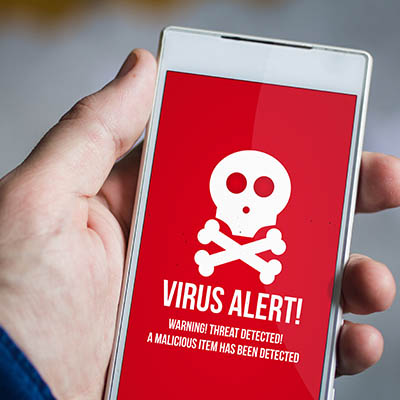Most of us are well aware that we need security software to keep our laptop and desktop computers from hackers and cyber-threats. It’s the first thing you do when you get a new device, because the risks are now well-known, even to casual computer users. But it shouldn’t stop there. Smartphones today are mini-computers that are also at risk.
Although cybercriminals were slower to target smartphones and mobile devices, the smartphone malware threat has been around for a long time, although at a lower level of intensity. It’s just that malware geared to phones hasn’t been as high profile as threats to laptops and desktop computers. But attacks against smartphones are just as much of a problem.
People don’t use phones in quite the same ways as they use home or office computers. Many people don’t use their phone quite as much for doing things like surfing the web or using email. More on this below. But if you do use your phone for these purposes, as well as installing those handy apps we all love, you could still be at risk. Those risks can be broken down according to whether you have an iOS or Android smartphone.
iPhone Security Risks
The iPhone’s iOS system is the safest mobile operating system around, according to Apple. It may have good security features but that doesn’t mean it’s immune to security attacks. If you’ve ‘hacked’ your iPhone to customize it (known as ‘jailbreaking’), then the built-in security restrictions may not be fully intact. If you haven’t, you have less to worry about, but there are other risks. A less common problem, but still one to be wary of, is what’s known as a zero-day hack. This is a major risk, which targets devices that haven’t updated their security soon after a security update is released.
An issue with the iPhone operating system is that there aren’t too many things you can do yourself to avoid problems. For the safety of your device you have to rely heavily on Apple itself. They don’t want their reputation damaged, so they’ll do their best, but you should still be alert to the possibility that iPhone security can be compromised your iPhone can be hacked or infected with smartphone malware.
Android Security Risks
It’s a different scenario with Android smartphones. Android devices are more at risk because there are so many different companies making Android phones. Different manufacturers use slightly different Android versions. If you have a Google Pixel and a Samsung Galaxy Note 10 then you’ll get security and other updates for them on a slightly different timetable.
The design of the Android system makes it more flexible and open than Apples iOS. This makes Android phones easier to customize and if you want to install apps that Google hasn’t vetted you’re free to do so. Again, customizing or ‘jailbreaking’ your phone can comprise the inbuilt android security measures.
Even apps from the Google Play Store aren’t necessarily safe, since some can carry smartphone malware. Google tries to deal with this, but there’s always room for error. Ultimately, it’s still down to the user, and being careful about which apps they choose to install on their phone. There’s no reason to ditch your Android phone or restrict employees from using Android devices to access company sites and systems. It comes down to how the device is used. Many people never have a malware problem with their Android phone.
Protecting Your Smartphone
- • Be careful what you install. There’s a reason why Android and iOS have their own app stores. It’s so that the apps you download are optimized for your phone and for maximum security. On Android phones it’s possible to install apps that aren’t in the Google Play Store but it may not be a smart idea. It may be harder to do this, and you may get a warning that it’s an app that could cause problems with your phone. To maximize security, don’t jailbreak your phone, go through the relevant app store and be discriminating about which apps you install, by checking out the reviews and the permissions the apps require.
- • Don’t get phished! Phishing attacks don’t actually depend on malware being installed on your device. They rely instead on users to make a mistake that will compromise the device’s security. Phishing attacks work like this: you get a message from a bank, store or other online account that looks perfectly authentic. But it isn’t. It’s designed to fool you into entering your login details or other credentials, which then get sent straight to the cybercriminals to use for their own purposes.
- • Use security software. If you have good security software for your laptop or desktop computer, check out whether they also offer protection for your Android device. Most security software providers have products designed to keep your smartphone safe, as well as your other devices.
- • Formulate a clear security policy. If you have staff who work on the move, who use smartphones and other mobile devices for work purposes, set up guidelines. Security features can include encryption, device locking and other measures. The way it usually works starts with your network. When users sign in to applications on their device, it will be checked to ensure it complies with the security requirements you’ve specified, and will block access if it doesn’t.
If you need help with mobile device security policies and protection of your company data, Quikteks can help. To learn more, give us a call at (973) 882-4644.

